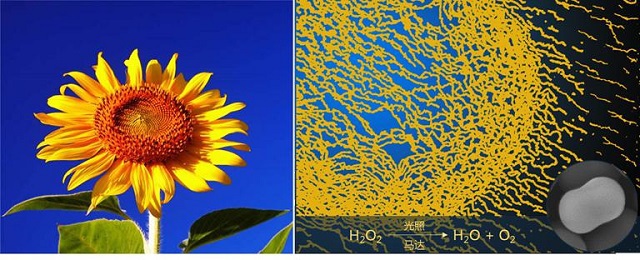Written by: Wang Xue
Translated by: Kang Ran
Edited by: D. Parker
Date: 2017-11-20
The research team led by Professor He Qiang from the research center of micro-nano technology of the Institute for Basic Interdisciplinary Science at Harbin Institute of Technology (HIT) has made important progress in group behavior of light-activated active colloid motors. Their results found a dynamic self-organization of self-propelled peanut-shaped hematite motors from non-equilibrium driving forces whose propulsion can be triggered by blue light. The group also discovered results in one-dimensional, active colloid ribbons with a positive photo tactic characteristics. Their research results were published in the world-renown journal, Angewandte Chemie International Edition (impact factors 12.0). The title of the article: “Light-activated Active Colloid Ribbons”.
Group behavior in nature can be seen everywhere, such as the growth of a bacterial community, group cooperation of insects, migration of birds and the schooling of fish. All of the above behave in groups and mutually care and help each other when they forage, rest and migrate. Inspired by the biotic community in nature, how to realize the clustering and dispersion of synthetic nanomachines has attracted much attention recently. This has been caused by the collective collaboration of nanomachines completing complex tasks which are beyond individual capabilities. On the other hand, the phototactic phenomenon is also very common, as seen in sunflowers reaching towards the sun and moths flying to the light. The phototactic characteristic of living creatures comes from the need of creatures to locate their own motion with lights (such as moths) or to convert light to energy more efficiently (as seen in sunflowers). However, it is still a great challenge for researchers to imitate the phototactic characteristic of living creatures to design biomimetic nanomachines. This kind of machine can draw energy from light to drive its own motion and humans can then easily control them to move to a specific position collectively by using light. Learning from nature, He Qiang and his research team have created a colloid ribbon which is self-organized with colloid motors triggered by light. This kind of self-propelled colloid ribbon is made up of peanut-shaped hematite motors. Triggered by blue light, the peanut-shaped hematite motors as a photo catalyst catalyze the decomposition of hydrogen peroxide in a solution, resulting in a hydrogen peroxide gradient. Then the hydrogen peroxide gradient induces a diffusio-osmotically self-propelled motion, providing the energy for the self-propulsion of the peanut-shaped hematite motors along their long axis. When the concentration of the colloidal motor is high, the diffusion-osmosis flow between motors disturb each other. This allows the motors to be assembled into a colloid ribbon along a one-dimensional collision. These colloid ribbons move toward the center of the light source in the light gradient field, exhibiting a phototactic orientation (similar with the action of moths flying to the light). They then form the sunflower-shaped dynamic assembly in the center of the light source. These self-propelled colloid motors can “feel” each other through the interaction of fluid fields. This demonstrates that under certain conditions, effective collision on the surfaces of colloid motors is enough to form an ordered dynamic assembly and achieve a stable collective directional motion. At the same time, the group behavior of these colloid motors shows the characteristic of the typical non-equilibrium system with a giant sized number fluctuation. The research results show that humans can artificially control the aggregation of self-propelled colloid motors with light and then make millions of motors move in one direction. Such photo tactic colloid ribbons may provide a model system to understand the emergence of function in biological systems. It may also have potential to construct self-organized bio-inspired active materials and nano robots based on different active building blocks.
Read more:http://onlinelibrary.wiley.com/doi/10.1002/anie.201708155/abstract



